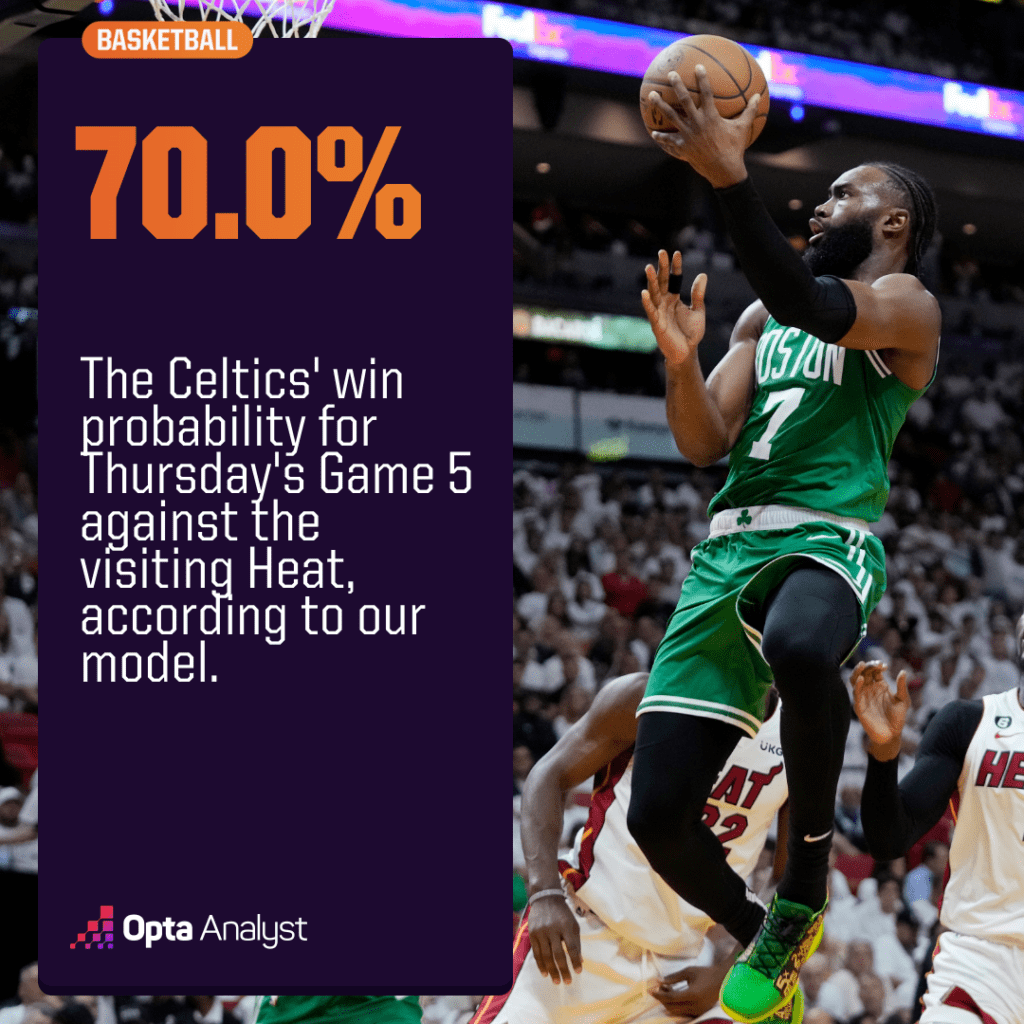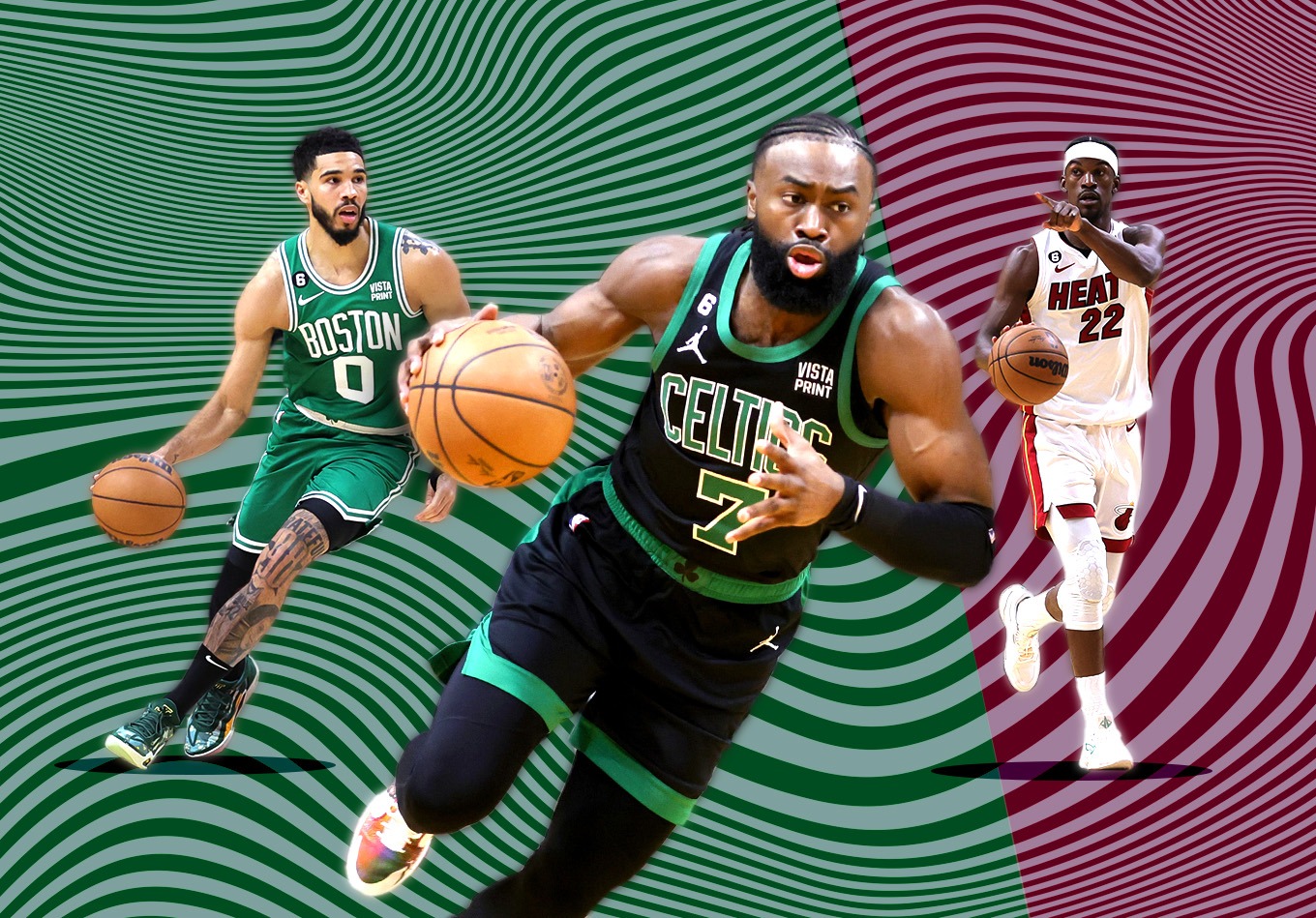The Boston Celtics were reeling.
After they turned it over for the fourth time in eight minutes, Max Strus leaked out and crammed home a dunk. Embarking upon a 14-3 run, Miami Heat led 22-15 and the clamor inside Kaseya Center roared to frenzied levels. Miami was aiming to complete a four-game sweep of this Eastern Conference matchup and earn a second NBA Finals berth in four years.
Instead, the Celtics didn’t wilt, took control in the second half for a 116-99 victory and extended their season for at least two more days. The formula resembled classic 2022-23 Boston basketball. Jayson Tatum starred with 33 points (14-of-22 shooting), 11 rebounds, seven dimes, two swats and one theft. Boston went 18 of 45 from beyond the arc and kept the turnovers to a minimum at 10, including just five after the first quarter.
Entering another do-or-die contest in Thursday’s Game 5, let’s assess where the Celtics excelled on Tuesday, how much is replicable and what the Heat might try to do to wrap up this series.
All season, the Celtics have prioritized taking and making long balls. It was the bedrock of their fourth-ranked offense (third in our adjusted offensive ratings) that finished second in 3-point rate (.480) and sixth in percentage (37.7) during the regular season. Through three Eastern Conference finals games, though, their 3-point rate was only .410 and they’d knocked down just 29.2% of their triples.
Both of those trends changed Tuesday, with a series-high .536 3-point rate and 40.0% clip. Sometimes to a fault, especially early on, they prioritized jacking up a ton of 3s. They soon settled in, however, and found their footing to fire away quality looks.
Aside from a heightened emphasis on seeking out 3s, Boston was much, much better about exploiting Miami’s aggressive gap help with swift decisions. When players were doubled, the Celtics got off the ball via a simple swing pass. When help came, everyone kept the wheels spinning. They acted quickly and shrewdly. Jaylen Brown enjoyed by far his best passing game of the series. Al Horford also set a flare screen on one play to help produce an open 3, a tactic I wouldn’t be surprised if Boston implemented more after its abbreviated Game 4 success.
The Heat were in rotation far more than they’d been during their three wins. It should not have required the Celtics to stare down elimination to play this way, but they’re here now and must maintain this approach for Game 5 (and beyond, if it reaches that point).
This is good offense. This is how to compromise a no-middle scheme that constantly has second and third bodies lurking on the ball. Their offense should have enough credible spacing, driving and connective passing threats to parlay snappy, sound decision-making into consistent, profitable offense against this Heat scheme. They haven’t always played like this in the series and that’s an overarching issue. They did Tuesday and need to continue it.
In a third quarter in which they won 38-23 and the entire second half, the Celtics even emptied the wings to neutralize Miami’s gap help altogether and provide considerable above-the-break spacing.
Tatum drilled some superstar-type shots, but it was by no means a coincidence he exploded for 25 points (11-of-15 shooting) and five assists after the first half. Look at all the real estate he operated with up top once Boston flattened out, stationing someone in the dunker spot and a shooter in either corner.
Miami brought a lot of doubles to Tatum that he impressively dissected before it reverted to single coverage later. I wonder how it opens Game 5, and whether Tatum and the Celtics do enough to spur another shift. Toggling across single coverage, early doubles and late help is probably the reality. Tatum grew far too comfortable for Miami’s liking against automatic doubles.
I expect the Celtics to embrace this vacant wing alignment for stretches of Game 5. Similarly, I anticipate Miami going back to its heralded 2-3 zone, where Bam Adebayo (or Cody Zeller) camps deep in the middle of the backline and the wings are brash, cheating up to challenge passes to the corners and offer reinforcements for those playing above the free-throw line.
Gabe Vincent has thrived helping spearhead this zone as one of the physical, pesky guard defenders, so his absence (sprained left ankle) could cast an impact there. Maybe, the Heat will roam more off of whoever’s in the dunker spot and trust someone else to guard 1-on-2. I don’t think they want those wings emptied as often as Boston accompanied that Tuesday night.
Boston will also welcome another standout night by Robert Williams III, who excelled as a deterrence and influencer defensively in Game 4. He gave Jimmy Butler some fits when he navigated the paint and tried to find his comfort zone of the short midrange. When his performance warrants more minutes, that gives the Celtics someone to man the dunker spot who can convert laydown passes on drives or clean up misses as an offensive rebounder. No other role players can provide those dynamics.
While Miami’s sloppy (15 turnovers), cold-shooting performance (8-of-32 from deep) ignited more fast break chances, Boston clearly pursued more early offense opportunities before the defense organized itself. Its 22% transition frequency was its top mark of the series and it averaged 123.2 points per 100 possessions on those plays. The Heat’s transition defense has generally been stout thus far, especially against Brown, Derrick White and Marcus Smart, so the push-pull of these angles is worth monitoring Thursday.
Defensively, the biggest tweak from the Celtics was how they elected to stop Adebayo as a roller. They routinely brought nail help to dissuade or poach pocket passes and loaded up on his path to the rim, even inviting ball handlers easy angles all the way inside and forcing them to be scorers. They’ve danced back and forth between nail help and staying home throughout the playoffs, but I’ve felt the nail help benefits their defense. It did in Game 4, as well as against the Philadelphia 76ers last round.
As a contrast, here are some buckets for Adebayo from Games 2 and 3 out of ball-screen actions.
Note the lack of nail help and how much more respect the initiators receive, which frees up Adebayo for finishes.
Heat coach Erik Spoelstra is a premier tactician, so he’ll probably draw up some sets to conflict that nail defender and carve out space for Adebayo’s dives. One problem, however, is Vincent’s injury leaves them pretty shallow in the guard department with Tyler Herro and Victor Oladipo already sidelined. Presumably, Kyle Lowry steps into the starting unit. He’s been good in the postseason and is a capable pick-and-roll conductor, but he’s struggled in this series, averaging 4.0 points on 24% true shooting since his 15-point Game 1.
The solution, then, might be to let Butler commandeer pick-and-rolls. The Celtics can live with Vincent and Lowry trying to finish with an open runway; they can’t survive with Butler parading to the rim if the big man is going to be tethered to Adebayo. That’s a natural remedy for Miami. Strong-side stunts from Boston on Butler’s pick-and-roll drives could be the counter to the counter.
Games 1 and 2 at TD Garden in Boston were electric. Miami took a 3-0 series lead that no one has come back from in NBA history. In Game 4, the Celtics unearthed some potentially sustainable improvements after halftime to preserve their season. Tatum hit his stride and sprung free against a swarming defense in Game 4. The Heat have been the better team this series and these NBA playoffs. They’re anchored by a wunderkind coach and bright lights superstar, the latter of whom struggled a bit on Tuesday.
Game 5 should be a treat.
Game 5 Win Probability
In terms of the moneyline, sportsbooks have the Celtics as the best bets (-305) in this matchup and the Heat as the underdogs (+240) Thursday night on TNT.
But who does our model project to win Game 5 of the Eastern Conference finals?

This model calculates win probability based on thousands of simulations. It incorporates the rankings from our previously mentioned adjusted team ratings (including overall adjusted team rating, adjusted offensive rating and adjusted defensive rating), accounts for recency bias (so, it gives more weight to teams playing well) and for how well teams have performed against other good teams.
Though the model has the Heat with a 67.9% chance of winning the series, it gives the Celtics a 70.0% probability of winning at home Thursday night.
Like this? Follow us on Twitter for more.
